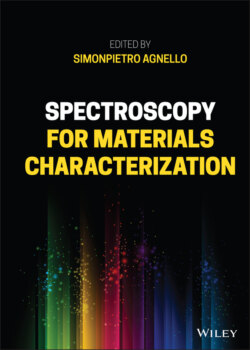Читать книгу Spectroscopy for Materials Characterization - Группа авторов - Страница 23
1.3.2 Light Sources
ОглавлениеThe first element of a spectrometer, as shown in Figure 1.7, is the light source. Different types of sources are usually employed in ultraviolet‐visible‐infrared (UV‐Vis‐IR) spectroscopy [2, 10, 22].
Incandescent lamp: it consists in a metallic filament (typically tungsten) inside a transparent glass bulb filled by halogen gas to maintain the filament. The filament is traversed by an electric current heating it by Joule effect and increasing its temperature [10]. A black body‐like emission occurs, giving a continuous spectrum comprising typically the Vis‐IR range.
Discharge arc lamp: a couple of electrodes (anode and cathode) are inserted in a transparent glass bulb filled by a low‐pressure gas of a given element (e.g. H, Hg, Na, Xe). By applying a high voltage (~1000 V) to the electrodes, a discharge occurs through the gas ionizing it. The ionized gas emits characteristic lines by the transition of the electrons through the excited states of the element. The ensuing spectrum is a line spectrum with a continuous background related to the temperature and the pressure of the gas. It is usual, for spectroscopy, to use high‐pressure discharge lamps to enhance the continuous background and employ them in a large spectral range. In particular, lamps with Xe are used for UV‐Vis emission spectroscopy and with Deuterium for UV and up to vacuum‐UV absorption and emission.
Laser [10]: various types of laser light are employed for spectroscopy due to their precise wavelength, spatial collimation, high intensity and time resolution in the pulsed regime [23]. These systems are realized with opportune cavities with reflecting walls to obtain the lasing effect.
Gas lasers (e.g. He–Ne: 633 nm; Ar: 514.5 nm; Kr: 647 nm) employ an electric discharge to ionize a low‐pressure gas and induce the population inversion. Typically, they are characterized by continuous wave emission.
Excimer lasers use mixture of gases [Xe, HCl, Ne (as buffer); Kr, F, He (as buffer)] at high pressure to obtain molecular complexes in the excited state (XeCl*, KrF*) through an electric discharge. During the excited state decay, a laser pulse is generated with duration in the window 5–20 ns. The population inversion is related to the disappearance of the ground state once the complex, which is unstable, dissociates.
Dye lasers use organic molecules in solution as laser active medium with emission in the range 300–1000 nm depending on the dye. The emission range is tunable up to 30 nm and can be pulsed by pumping it with an excimer laser.
Solid state lasers have been the first system used by Maiman in 1960 to prove coherent emission [24]. They include the first member of the family, the Ruby laser (Al2O3:Cr3+, 694.3 nm), the Nd‐YAG laser (1064 nm), and the Ti‐sapphire laser (Al2O3:Ti3+, ~800 nm, wide band). In these systems, a pumping lamp populates an excited state starting from which a long lifetime excited state is successively populated, inducing a population inversion and the following stimulated emission. The emission can be pulsed and a timescale of nanoseconds or down to femtoseconds can be reached. Furthermore, due to the high intensity of some of these systems, nonlinear effects can be obtained through nonlinear optics to generate harmonics or continuous very fast pulsed emission.
Diode lasers are light emitting systems using semiconductors [23, 25]. They are solid structures of layered semiconductors with opportune bandgap tuning. This way, it is possible to obtain recombination of electrons and holes in a direct bandgap region. The charge injection by an external electric potential enables the emission of photons in this active region. By opportune combination of the constituting elements of the semiconductors (for example changing the x balance in Ga1−x Al x As), the emission can be engineered. The typical commercial diode lasers emit in the UV‐Vis‐IR range.
